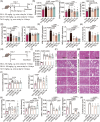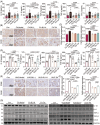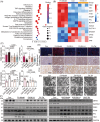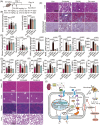Butyrolactone I blocks the transition of acute kidney injury to chronic kidney disease in mice by targeting JAK1
- PMID: 39845897
- PMCID: PMC11751251
- DOI: 10.1002/mco2.70064
Butyrolactone I blocks the transition of acute kidney injury to chronic kidney disease in mice by targeting JAK1
Abstract
Chronic kidney disease (CKD) is a disease that affects more than 850 million people. Acute kidney injury (AKI) is a common cause of CKD, and blocking the AKI-CKD transition shows promising therapeutic potential. Herein, we found that butyrolactone I (BLI), a natural product, exerts significant nephroprotective effects, including maintenance of kidney function, inhibition of inflammatory response, and prevention of fibrosis, in both folic acid- and ureteral obstruction-induced AKI-CKD transition mouse models. Notably, BLI showed greater blood urea nitrogen reduction and anti-inflammatory effects than telmisartan. Bioinformatics analysis and target confirmation assays suggested that BLI directly binds to JAK1, and kinase inhibition assay confirmed it is a potent JAK1inhibitor with an IC50 of 0.376 µM. Experiments in JAK1-knockdown mice also proved that BLI targets JAK1 to work. Furthermore, BLI demonstrated nephroprotective effects and safety comparable to ivarmacitinib, the well-known JAK1 inhibitor. Mechanistically, BLI targets JAK1 and inhibits its phosphorylation and JAK-STAT activation, subsequently regulating the downstream signaling pathways to inhibit reactive oxygen species production, inflammation, and ferroptosis, thereby preventing the occurrence of kidney fibrosis and blocking the AKI-CKD transition process. This study demonstrates for the first time that BLI is a JAK1 inhibitor and a promising candidate for delaying CKD progression, which warrants further investigation.
Keywords: AKI–CKD transition; JAK1; butyrolactone I; ferroptosis.
© 2025 The Author(s). MedComm published by Sichuan International Medical Exchange & Promotion Association (SCIMEA) and John Wiley & Sons Australia, Ltd.
Conflict of interest statement
The authors declare no conflicts of interest.
Figures








Similar articles
-
STAT3 blockade ameliorates LPS-induced kidney injury through macrophage-driven inflammation.Cell Commun Signal. 2024 Oct 4;22(1):476. doi: 10.1186/s12964-024-01841-1. Cell Commun Signal. 2024. PMID: 39367511 Free PMC article.
-
Role of SIK1 in the transition of acute kidney injury into chronic kidney disease.J Transl Med. 2021 Feb 15;19(1):69. doi: 10.1186/s12967-021-02717-5. J Transl Med. 2021. PMID: 33588892 Free PMC article.
-
TNF or EGFR inhibition equally block AKI-to-CKD transition: opportunities for etanercept treatment.Nephrol Dial Transplant. 2023 May 4;38(5):1139-1150. doi: 10.1093/ndt/gfac290. Nephrol Dial Transplant. 2023. PMID: 36269313 Free PMC article.
-
The Road from AKI to CKD: Molecular Mechanisms and Therapeutic Targets of Ferroptosis.Cell Death Dis. 2023 Jul 13;14(7):426. doi: 10.1038/s41419-023-05969-9. Cell Death Dis. 2023. PMID: 37443140 Free PMC article. Review.
-
Nanomedicine embraces the treatment and prevention of acute kidney injury to chronic kidney disease transition: evidence, challenges, and opportunities.Burns Trauma. 2024 Nov 29;12:tkae044. doi: 10.1093/burnst/tkae044. eCollection 2024. Burns Trauma. 2024. PMID: 39678075 Free PMC article. Review.
Cited by
-
Anthraquinones from Rheum officinale Ameliorate Renal Fibrosis in Acute Kidney Injury and Chronic Kidney Disease.Drug Des Devel Ther. 2025 Jul 6;19:5739-5760. doi: 10.2147/DDDT.S521265. eCollection 2025. Drug Des Devel Ther. 2025. PMID: 40657042 Free PMC article. Review.
-
Huangkui capsule combined with finerenone attenuates diabetic nephropathy by regulating the JAK2/STAT3 signaling pathway based on network pharmacology, molecular docking, and experimental verification.Front Pharmacol. 2025 Aug 4;16:1625286. doi: 10.3389/fphar.2025.1625286. eCollection 2025. Front Pharmacol. 2025. PMID: 40832613 Free PMC article.
-
Yuanhuacine modulates lipopolysaccharide-induced interleukin-6 through regulation of the JAK1/STAT3 pathway and prevents tubular damage in acute kidney injury.Exp Ther Med. 2025 Jul 3;30(3):168. doi: 10.3892/etm.2025.12918. eCollection 2025 Sep. Exp Ther Med. 2025. PMID: 40692765 Free PMC article.
References
-
- Kalantar‐Zadeh K, Jafar TH, Nitsch D, Neuen BL, Perkovic V. Chronic kidney disease. Lancet. 2021;398(10302):786‐802. - PubMed
-
- Kellum JA, Romagnani P, Ashuntantang G, Ronco C, Zarbock A, Anders H‐J. Acute kidney injury. Nat Rev Dis Primers. 2021;7(1):52. - PubMed
-
- Levin A, Ahmed SB, Carrero JJ, et al. Executive summary of the KDIGO 2024 clinical practice guideline for the evaluation and management of chronic kidney disease: known knowns and known unknowns. Kidney Int. 2024;105(4):684‐701. - PubMed
-
- Lv J‐C, Zhang L‐X. Prevalence and disease burden of chronic kidney disease. In: Liu B‐C, Lan H‐Y, Lv L‐L, eds. Renal Fibrosis: Mechanisms and Therapies. Springer; 2019:3‐15. - PubMed
LinkOut - more resources
Full Text Sources
Research Materials
Miscellaneous
